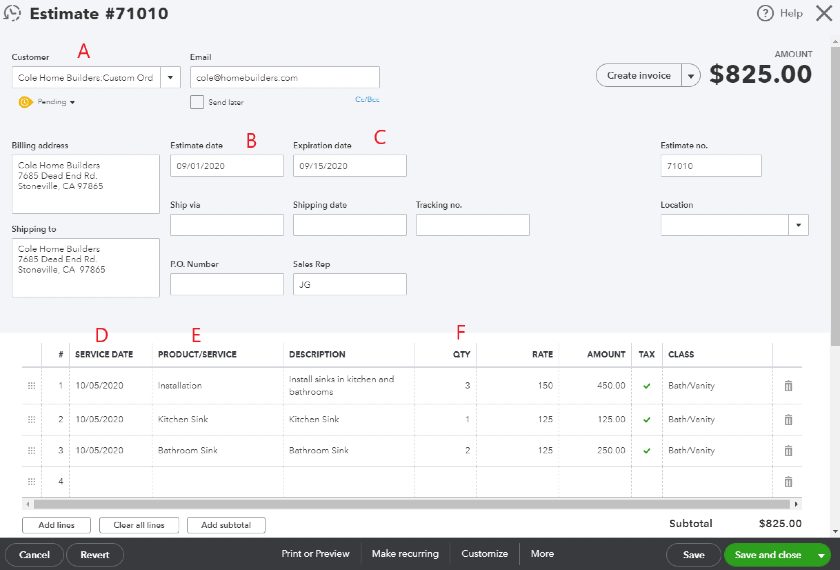

- #QUICKBOOKS CONTRACTOR PRO QUICK WAY TO CREAT QUOTE MANUAL#
- #QUICKBOOKS CONTRACTOR PRO QUICK WAY TO CREAT QUOTE SOFTWARE#
- #QUICKBOOKS CONTRACTOR PRO QUICK WAY TO CREAT QUOTE PROFESSIONAL#
Then you can start progress invoicing – invoices that are sent at each stage of progress as identified in your contract with your client. What is Progress Invoicing and How Do You Use It?īefore you begin work on a new project, you convert the client’s estimate into an invoice. When you’re ready to run those reports mentioned above, you don’t have to re-enter any of this data – it’s all already there. This feature lets you send out invoices according to a schedule you set, and everything that’s already been paid or is still outstanding is kept track of within QuickBooks. If you plan on progress invoicing, this feature is especially invaluable. If you want to be able to run these reports, you must enter your figures in the QuickBooks system – and it takes no more input than what you’re already inputting in your current system.Īnd, in just a few clicks of your mouse, those estimate figures can become invoices. Your workflow numbers depend on your estimate figures, for aspects such as accounting, time tracking for payroll and job costs. In other words, every job you begin starts with an estimate. Why do you ask? Because your estimates are the figures from which all other figures come. You can always stay with that program if you’re comfortable – but if you want the added benefits of estimates, invoicing, and job cost reports, as well as several other tasks, you have to enter your estimate figures into QuickBooks.

#QUICKBOOKS CONTRACTOR PRO QUICK WAY TO CREAT QUOTE SOFTWARE#
For each estimate you create, you can automatically convert it into an invoice should the potential customer become your client.Īs a contractor, you might already have a software program you use for your estimates. Use your estimate to make an invoice efficiently.If you perform the same types of tasks rather frequently, you can take advantage of the Memorize Estimate feature. Streamline the estimate process by saving jobs.Save estimates for future use on other projects.Try to make several different estimates for each job to see how your numbers change when manipulating data points.

If you’re new to the world of construction, QuickBooks has some tips to help you create an estimate: To create an estimate, enter items in your item list, enter the estimated amount.

With QuickBooks, you can create your documents using hundreds of included templates and customize them to your liking.
#QUICKBOOKS CONTRACTOR PRO QUICK WAY TO CREAT QUOTE PROFESSIONAL#
Professionalism – Your company is professional – anything that leaves your office, especially your estimates and invoices, should look professional. If roofing shingles don’t get added to the estimate or invoice, you might have a hard time explaining to your new customer why their price suddenly jumped later on. You can also use the item list to make sure no items used in the job are overlooked. Īccuracy – Your estimate and invoice calculations are done for you. An added benefit is that all this information is at your fingertips when it comes time to run a job cost report. And once you commence work, you can convert your estimate into an invoice with just a few clicks. Time efficiency – Using QuickBooks, you can avoid double- and even triple-entry concerning your estimate data.
#QUICKBOOKS CONTRACTOR PRO QUICK WAY TO CREAT QUOTE MANUAL#
There’re a few different ways you can create estimates – manually on paper, in a spreadsheet program, or automatically using QuickBooks.Ĭreating an estimate using QuickBooks has several advantages over manual methods, such as: By comparing these, over time you begin to see where your estimates are too high and where they’re too low, thereby improving future estimates – for you and your potential clients. Also known as the job cost analysis, one of the critical aspects is comparing your estimated costs for labour, materials, etc. When you prepare an estimate, you’re estimating the data surrounding that particular job. On the flipside, if you bid too low, you can appear unprofessional – but you can also lose big money if someone bites. If you bid too high, clients go elsewhere. Giving proper estimates is critical to your firm’s success however, creating those estimates is sometimes tricky.


 0 kommentar(er)
0 kommentar(er)
